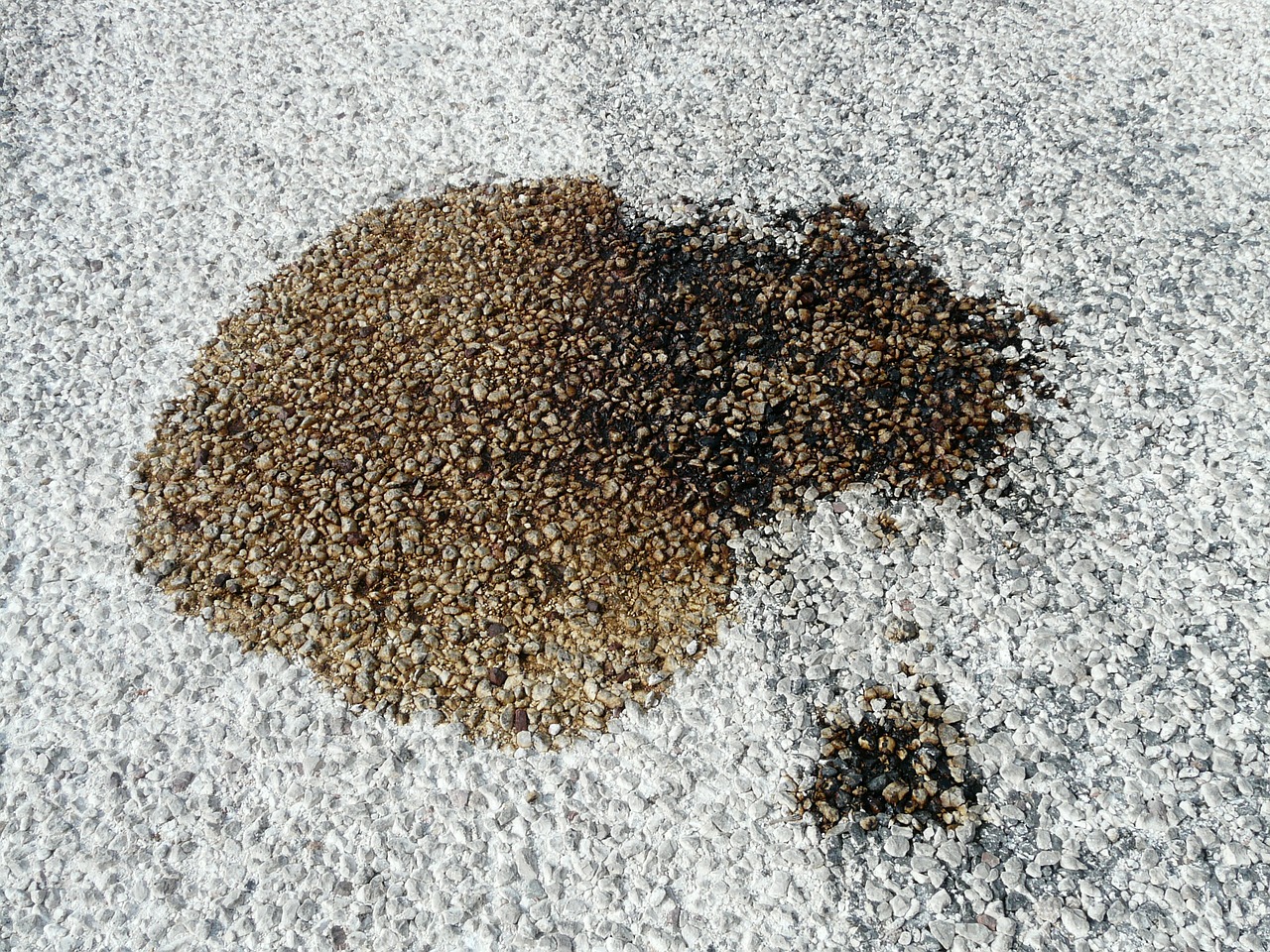Brake fluid can cause stubborn stains on asphalt due to its chemical composition. The fluid contains corrosive substances that can deteriorate and discolor the asphalt surface.
Asphalt is commonly used for driveways and parking lots due to its durability and low maintenance. However, exposure to brake fluid can lead to unsightly stains that are difficult to remove. Understanding the impact of brake fluid on asphalt can help in taking preventive measures and addressing any spills promptly.
We will delve into the reasons behind brake fluid stains on asphalt and explore effective ways to prevent and remove these stains. We will also discuss the importance of proper maintenance to preserve the appearance and functionality of asphalt surfaces.

Credit: www.reddit.com
The Composition Of Brake Fluid
Brake fluid is a crucial component in a vehicle’s braking system, responsible for transmitting the pressure from the driver’s foot on the brake pedal to the brake pads or shoes, enabling the vehicle to slow down or stop completely. But have you ever wondered about the composition of this important fluid and whether it can cause stains on asphalt surfaces? Let’s dive into the chemical components, viscosity, and texture of brake fluid to gain a better understanding.
Chemical Components
Brake fluid is typically composed of various chemical components that allow it to perform its function effectively. The most common type of brake fluid used in automobiles is known as glycol-based brake fluid. It is a mixture of glycols, such as polyethylene glycol or polypropylene glycol, as well as additives to enhance its performance and stability. These additives often include rust inhibitors, corrosion inhibitors, and anti-foaming agents.
In addition to glycol-based brake fluids, there is also a type called silicone-based brake fluid, which is less common but used in specific applications. Silicone-based brake fluids are composed of silicone polymers, which offer different characteristics compared to glycol-based fluids. It is important to note that mixing different types of brake fluids can lead to severe braking system failure and should be avoided.
Viscosity And Texture
The viscosity of brake fluid refers to its resistance to flow. It is a critical property as it affects the performance of the braking system. Brake fluid needs to have an optimal viscosity to ensure that it flows smoothly through the brake lines and hydraulic components, allowing for effective braking. If the fluid’s viscosity is too high, it may impede the flow and reduce braking performance, while if it is too low, it may lead to fluid leakage and potential brake failure.
The texture of brake fluid can vary depending on its composition. Most glycol-based brake fluids have a clear or amber color and a slimy texture. This sliminess helps to lubricate the various components of the braking system, preventing excessive wear and tear. Silicone-based brake fluids, on the other hand, are usually translucent and have a slightly different, less slimy texture compared to glycol-based fluids.
To summarize, brake fluid is typically composed of glycols, additives, and in some cases, silicone polymers. The viscosity and texture of brake fluid are important factors that ensure its proper functioning within the braking system. Now that we have a better understanding of the composition of brake fluid, let’s explore whether it can cause stains on asphalt surfaces.
The Impact On Asphalt
The Impact on Asphalt:
Reaction With Asphalt:
Brake fluid can chemically react with asphalt, causing damage and discoloration.
Stain Formation:
When brake fluid spills on asphalt, it can penetrate, dissolve, and lead to unsightly stains.
Environmental Concerns
Brake fluid spills on asphalt can have severe environmental consequences, especially posing risks to the ecosystem. Understanding the long-term effects is crucial to mitigate potential damage.
Ecosystem Impact
Spills of brake fluid on asphalt can directly contaminate soil and groundwater, harming plants and aquatic life.
Long-term Consequences
Brake fluid stains on asphalt may persist and leach harmful chemicals into the environment, causing prolonged damage. Preventive actions are vital to safeguard ecosystems.

Credit: blacktopconcepts.com
Methods Of Removal
When it comes to brake fluid stains on asphalt, knowing the right methods of removal is crucial. While brake fluid may seem impossible to remove, especially from porous surfaces like asphalt, there are effective techniques that can help you get rid of these stubborn stains. In this article, we will discuss the different methods you can use to clean brake fluid stains from asphalt, as well as preventative measures to keep your asphalt looking clean and pristine.
Cleaning Techniques
If you’re dealing with brake fluid stains on your asphalt, here are some effective cleaning techniques that you can try:
- Immediate action: As soon as you notice a brake fluid spill on your asphalt, it’s important to act quickly. Use a clean cloth or paper towel to blot the spill and absorb as much of the fluid as possible. This can help prevent the stain from spreading and penetrating deeper into the asphalt.
- Dish soap and water: Mix a solution of dish soap and water in a bucket. Scrub the stained area using a stiff-bristled brush and the soapy solution. Rinse the area thoroughly with clean water to remove any soap residue. This method can be effective for light brake fluid stains.
- Baking soda paste: Create a paste by mixing baking soda with water. Apply the paste to the stained area and let it sit for at least 30 minutes. Scrub the area gently using a brush, then rinse with water. Baking soda is known for its powerful stain-removing properties and can be highly effective in removing tough brake fluid stains.
- Commercial degreasers: There are various commercial degreasers available that are specifically formulated to remove oil and grease stains from asphalt. Follow the instructions on the product label and use as directed. These degreasers often require you to apply the product, let it sit for a specified period, and then rinse it off with water.
Preventative Measures
Preventing brake fluid spills on your asphalt can save you from the hassle of having to remove stains later. Here are some preventative measures you can take:
- Protective mats: Place a protective mat or tray under your vehicle’s braking system when performing any maintenance or repairs. This can help catch any potential brake fluid leaks and prevent them from seeping into the asphalt.
- Regular inspections: Routinely inspect your vehicle’s braking system for any signs of leaks or damage. By catching and addressing brake fluid issues early on, you can prevent major spills that could stain your asphalt.
- Proper disposal: When disposing of used brake fluid, make sure to follow local regulations and dispose of it properly. Avoid pouring it onto the ground or down drains where it can contaminate the environment and potentially stain asphalt surfaces.
- Professional maintenance: Regularly maintain and service your vehicle’s braking system to ensure it is in good working condition. Promptly address any leaks or issues to prevent brake fluid stains on your asphalt.
Regulatory Measures
Regulatory measures play a crucial role in governing the use of brake fluid and its potential to cause stains on asphalt. Both legal restrictions and industry guidelines are in place to ensure the proper handling and disposal of brake fluid, minimizing its impact on the environment and infrastructure.
Legal Restrictions
Federal and state regulations dictate the proper disposal of brake fluid to prevent contamination of soil and water sources. Improper disposal may lead to fines or penalties, making it imperative for individuals and businesses to adhere to these regulations.
Industry Guidelines
The automotive industry has established specific guidelines for the handling and disposal of brake fluid. Manufacturers and service providers are required to follow these guidelines to protect the environment and infrastructure from potential damage caused by brake fluid stains on asphalt.

Credit: www.reddit.com
Alternative Fluid Options
Eco-friendly Alternatives
When considering alternative brake fluid options for your vehicle, it’s important to explore eco-friendly choices that minimize environmental impact. Biodegradable brake fluids are gaining popularity due to their eco-friendly composition. These fluids are designed to degrade naturally and reduce harm to the environment, offering a sustainable solution for conscientious vehicle owners. Additionally, silicone-based brake fluids are considered environmentally friendly as they do not pose a threat to water and soil, making them a sustainable choice.
Performance Comparison
When comparing alternative brake fluid options, it’s essential to consider their performance in various conditions. Biodegradable fluids have demonstrated efficient performance in typical driving scenarios, offering comparable braking capabilities to traditional brake fluids. On the other hand, silicone-based fluids exhibit stable performance across a wide range of temperatures, ensuring reliable braking performance in diverse environmental conditions.
The Role Of Maintenance
Regular maintenance plays a crucial role in ensuring the longevity and proper functioning of your vehicle. Brake fluid, being an integral component of your braking system, requires proper maintenance to avoid any potential damage to your asphalt driveway or parking lot. By conducting routine vehicle checks and seeking professional inspections, you can effectively prevent brake fluid stains on your asphalt surfaces.
Vehicle Checks
Performing regular vehicle checks is an essential part of maintenance that helps you identify any potential issues with your brake fluid. By keeping an eye on the level, color, and condition of your brake fluid, you can spot any leaks or contamination early on and take prompt action. Here are a few simple yet important vehicle checks to keep in mind:
- Check the brake fluid reservoir for any signs of leakage or overfilling.
- Inspect the color of the brake fluid. It should be transparent or slightly yellowish, indicating it is in good condition.
- If the brake fluid appears dark or contaminated, it may require immediate replacement.
- Pay attention to any unusual odors coming from your brake system, as it could be a sign of contamination or a leak.
Professional Inspections
While regular vehicle checks are important, seeking professional inspections for your vehicle is equally crucial. Trained technicians can provide a comprehensive evaluation of your brake fluid’s condition and overall braking system. Here’s why professional inspections matter:
- Technicians have the expertise to assess the quality and performance of your brake fluid accurately.
- They can identify any underlying issues with your braking system that may be causing excessive fluid leakage.
- Professional inspections ensure that your brake fluid is adequately maintained, reducing the risk of stains on your asphalt surfaces.
- Technicians can recommend the appropriate brake fluid type and replacement intervals based on your vehicle’s requirements.
- By entrusting your vehicle to professionals, you gain peace of mind knowing that your braking system is in optimal condition.
Remember, by conducting regular vehicle checks and seeking professional inspections, you can effectively prevent brake fluid stains on your asphalt surfaces. Prioritizing maintenance not only safeguards the functionality of your vehicle but also helps preserve the appearance of your asphalt driveway or parking lot for years to come.
Conclusion
Brake fluid can indeed cause stains on asphalt surfaces. It is crucial to address any spills promptly to prevent long-term damage. By understanding the nature of brake fluid and its chemical composition, one can take necessary precautions to minimize the impact on asphalt.
Regular maintenance and adherence to safety guidelines will help maintain the integrity of both the brake fluid and the asphalt surface. Stay vigilant and proactive to ensure a clean and pristine environment.


